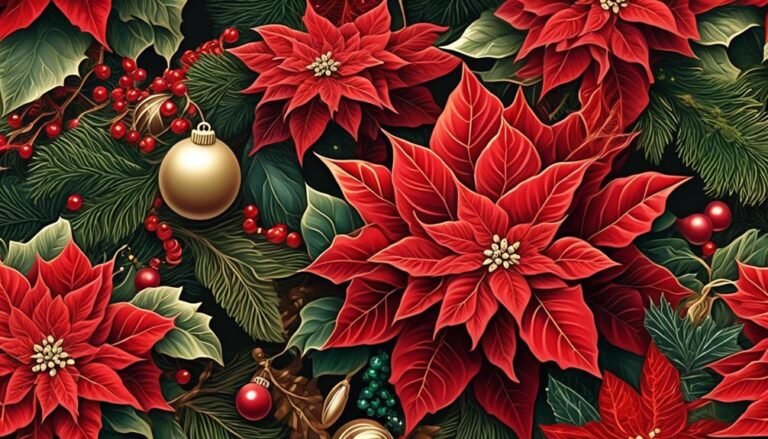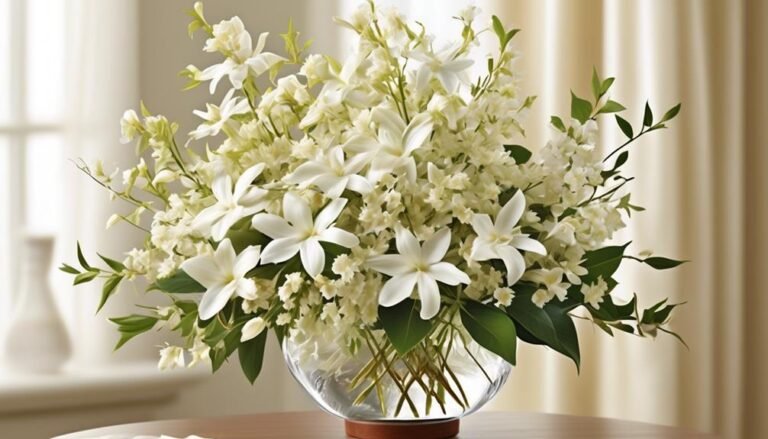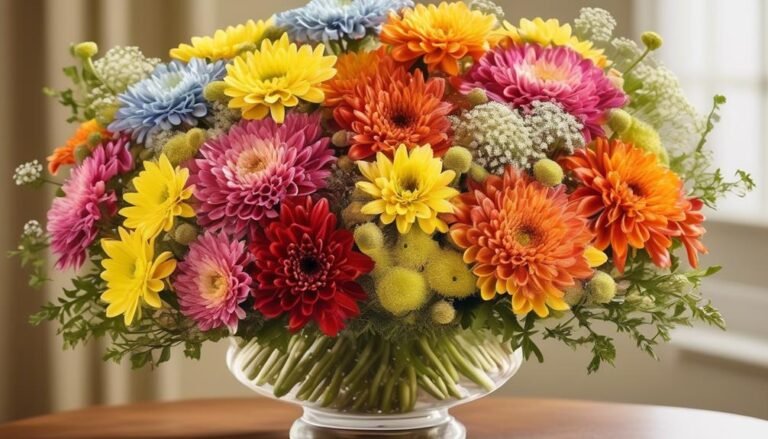What Is The Christmas Flower? Let’s Look At Some of History of The Poinsettia as a Christmas Plant
What Is The Christmas Flower? It’s The Amazing Poinsettia of Course!!

Acting as a vibrant Christmas plant that seems to spring from a beautiful painting, the poinsettia brings the holiday season to life with its dark green leaves and vivid bracts that bear a resemblance to gentle petals.
In this article, we’ll take a detailed look into the rich history and profound cultural importance of the poinsettia, a favourite Christmas plant.
Hailing from North and Central America, the poinsettia has found a cherished home in many hearts, steadily growing into an emblem of the Christmas tree.
With millions sold each year, it has become a staple decoration in homes and businesses worldwide.
Rest assured, despite popular opinion, the poinsettia, unlike certain types of flowers and plants, is not highly toxic to either humans or pets.
So, let’s continue onwards into the wonders of the Christmas flower and discover its timeless beauty.
Table of Contents
Key Takeaways
- The poinsettia is associated with Christmas due to a Mexican legend and its natural winter blooming.
- The poinsettia, similar to the vibrant holly and amaryllis, is a poignant symbol of love, joy, and the act of giving during the holiday season.
- Similar to Christmas roses and orchids, poinsettias are purposefully cultivated in controlled environments for use during the festive season.
- Though poinsettias are not as deadly as some other flowers and plants, some caution should still be exercised around children and pets.
History and Origins
Now let’s delve into the history and origins of the Christmas flower, starting with its cultural significance and how it came to be associated with the holiday season.
Much like wreaths and holly, the poinsettia, boasting vibrant red bracts, has evolved into a quintessential symbol of Christmas, festooning homes, churches, and public spaces throughout the festive season. But how did this beautiful flower become so closely tied to this joyous holiday?
The history of the poinsettia as a Christmas flower can be traced back to a Mexican legend. In this tale, a young girl named Pepita is desperate to present a gift to baby Jesus, but like a bare Christmas tree, she had nothing to offer. An angel then appeared to Pepita, guiding her to gather weeds from the roadside, just like a wild cyclamen. Following the angel’s advice, Pepita collected a bunch of green weeds, reminiscent of a sparse Christmas tree. Miraculously, when she set them in front of the nativity scene, they morphed into gorgeous red flowers, becoming the poinsettias we adore today, equally captivating as an amaryllis or a Christmas cactus in bloom.
This riveting legend, coupled with the natural winter blooming of the poinsettia much like the Christmas cactus, fastened a strong connection between this flower and the Christmas season. The vivid hue of the poinsettia’s bracts, similar to the bold red of the Christmas rose, symbolizes Christ’s blood, while the formation of its leaves draws comparisons to the star of Bethlehem.
In the early 19th century, a man named Joel Poinsett, who was an ambassador to Mexico, discovered the flower and brought it back to the United States. He fell in love with its beauty and began cultivating it in his greenhouse, sharing it with friends and botanical gardens. The flower was eventually named after him, solidifying its place in history.
Today, the poinsettia is enjoyed worldwide as a symbol of love, joy, and renewal during the Christmas season. Its rich history and cultural significance make it a cherished part of holiday traditions around the globe.
Cultural Significance
To understand the cultural significance of the Christmas flower, let’s explore its symbolic meaning and how it has become deeply intertwined with holiday traditions worldwide.
The Christmas flower, also known as the poinsettia, is a vibrant and eye-catching plant that features striking red petals. These red petals are often associated with the colour of the star of Bethlehem, which is said to have guided the three wise men to the birthplace of Jesus.
The poinsettia’s association with Christmas dates back to a Mexican legend. It’s believed that a young girl named Pepita was saddened because she had no gift to present to baby Jesus at the Christmas Eve service. As she walked to the church, an angel appeared and told her to gather weeds from the roadside. Pepita followed the angel’s instructions and placed the weeds in front of the nativity scene. Miraculously, the weeds transformed into beautiful red flowers, which became known as poinsettias.
This legend not only gave birth to the tradition of using poinsettias as a Christmas decoration but also symbolizes the importance of giving from the heart. The poinsettia’s vibrant red colour serves as a reminder of love, joy, and the spirit of giving that’s celebrated during the holiday season.
The cultural significance of the Christmas flower extends far beyond its symbolic meaning. In many countries, the poinsettia is an integral part of Christmas celebrations. It’s used to decorate homes, churches, and public spaces, adding a festive touch to the surroundings. The popularity of poinsettias during Christmas has made them a staple in holiday decorations and a symbol of the season’s warmth and beauty.
To truly appreciate the cultural significance of the poinsettia, it’s important to recognize its impact on holiday traditions worldwide. The Christmas flower, with its vibrant red petals, symbolizes love, joy, and the spirit of giving. Whether adorning a festive table or brightening up a room, the poinsettia is a beloved and iconic symbol of Christmas that brings warmth and beauty to the festive season.
Commercial Cultivation
You can find the Christmas flower, or poinsettia, being commercially cultivated all around the world. These vibrant and festive plants are grown specifically for the holiday season, making them one of the most popular Christmas flowers. With their striking red, white, and pink bracts, poinsettias add a touch of colour and beauty to any winter setting.
Commercial cultivation of poinsettias is a meticulous process that requires careful attention to detail. It begins with selecting the highest quality plants, which are then propagated through cuttings. These cuttings are carefully nurtured in controlled environments until they develop sturdy roots. Once rooted, the young poinsettias are transferred to larger pots and placed in greenhouses.
In these greenhouses, the poinsettias are provided with the ideal conditions for growth. They require plenty of sunlight, warmth, and proper irrigation. The temperature and humidity are closely monitored to ensure optimal development. Skilled growers also apply specialized techniques to shape the plants into their characteristic bushy and compact form.
As the holiday season approaches, the poinsettias are carefully timed to bloom just in time for Christmas. This requires precise manipulation of light and darkness to induce the formation of the colourful bracts. Once the poinsettias have reached their peak, they’re harvested and prepared for distribution.
Poinsettias have become one of the most popular winter houseplants, adorning homes, offices, and public spaces during the holiday season. They’re shipped to various locations, both domestically and internationally, to meet the high demand. The commercial cultivation of poinsettias not only provides a beautiful decoration but also supports the livelihoods of many growers and nurseries around the world.
Myth Debunked: Poinsettias and Toxicity
If you’ve ever been concerned about the toxicity of poinsettias, let me put your mind at ease. Contrary to popular belief, poinsettias are not highly toxic to humans or pets. While it is true that contact with the plant may cause mild gastrointestinal discomfort or skin rash, the level of toxicity is relatively low. The idea that poinsettias are dangerous is nothing more than a myth that has been debunked.
To further illustrate the low toxicity of poinsettias, let’s take a look at a comparison table showcasing the toxicity levels of some common household plants:
| Plant | Level of Toxicity |
|---|---|
| Poinsettia | Low |
| Philodendron | Moderate |
| Dieffenbachia | High |
| Peace Lily | Moderate |
| Snake Plant | Low |
As you can see, poinsettias fall into the low toxicity category, along with other popular plants like snake plants. While it’s always important to exercise caution and keep plants out of reach of curious children or pets, you can rest assured that poinsettias pose minimal danger.

Care Tips for Poinsettias
Taking care of poinsettias is relatively easy, and with regular watering, they can thrive throughout the holiday season. To ensure that your poinsettias stay healthy and vibrant, here are some care tips to remember.
First and foremost, poinsettias are native to warm climates, so they prefer temperatures between 60 and 70 degrees Fahrenheit. Keep them away from drafts or cold windows, as they’re sensitive to cold temperatures. Additionally, make sure to place them in a well-lit area where they can receive indirect sunlight for at least six hours a day.
When it comes to watering, be careful not to overdo it. Poinsettias like to be kept slightly moist, but not waterlogged. It’s best to check the soil regularly by sticking your finger about an inch into the soil. If it feels dry, then it’s time to water. However, if it still feels moist, hold off on watering for a little longer.
Another important aspect of caring for poinsettias is fertilization. These plants benefit from regular feeding, but be sure to use a balanced, water-soluble fertilizer that’s specifically formulated for potted plants. Follow the instructions on the packaging for the correct dosage and frequency of application.
Lastly, keep in mind that poinsettias are sensitive to certain pests, such as aphids and whiteflies. To prevent infestations, periodically inspect your plants for any signs of pests and take appropriate measures, such as using insecticidal soap or neem oil.
Frequently Asked Questions
What Is the Traditional Christmas Flower?
The traditional Christmas flower is the poinsettia. With its vibrant red and green colours, it symbolizes the holiday season and is a popular decoration.
Native to North and Central America, specifically Mexico and Guatemala, the poinsettia is a shrub or small tree with dark green leaves and coloured bracts that resemble petals.
Millions of poinsettias are sold each year in the United States alone.
Although misconceptions exist, poinsettias aren’t highly toxic to humans or pets.
What Is Christmas Flower Called?
The Christmas flower, also known as the poinsettia, is a vibrant and iconic plant that brings joy to the holiday season. With its deep red bracts and dark green leaves, it symbolizes the festive colours of Christmas.
Originating from Mexico and Guatemala, the poinsettia has become a beloved decoration in homes and businesses around the world. Its popularity stems from its cultural significance and its ability to add a touch of beauty and cheer to any festive setting.
What Is the National Flower of Christmas?
The national flower of Christmas, my friend, is the poinsettia. With its vibrant red and green colours, this subtropical plant hails from Mexico and symbolizes the holiday season.
It’s a popular choice for decorations, with millions sold each year in the US alone. Poinsettias thrive in bright, filtered sunlight and are cultivated as potted plants.
What Is the Flower That Blooms at Christmas?
At Christmas, there’s a special flower that blooms with vibrant colours, adding beauty to the holiday season. This flower is known for its iconic red and green foliage, and it’s called the poinsettia.
Native to North and Central America, the poinsettia has cultural significance and is commonly associated with Christmas. Millions of poinsettias are sold each year, making it a popular decoration.
Q: What is the history of the poinsettia as a Christmas plant?
A: The poinsettia, also known as Euphorbia pulcherrima, is native to Mexico and was brought to the United States by Joel Poinsett in the early 1800s. It became associated with Christmas due to its red and green foliage, which symbolizes the colours of the holiday season.
Q: Can poinsettias be grown indoors?
A: Yes, poinsettias can be grown indoors as long as they are placed in a location with bright, indirect sunlight and kept away from drafts and heat sources.
Q: How can I keep my poinsettia looking its best around Christmas?
A: To keep your poinsettia looking its best, place it in a room with plenty of natural light and avoid overwatering. It’s best to let the soil dry out slightly between watering to prevent root rot.
Q: What are some other popular Christmas plants and flowers?
A: Some other popular Christmas plants and flowers include amaryllis, Christmas cactus, holly, mistletoe, and the Christmas rose. These plants are often used for holiday decorations and gift-giving.
Q: How long do poinsettias typically bloom?
A: Poinsettias typically bloom for four to six weeks, making them a perfect Christmas bloom to brighten up the holiday season.
Q: Are poinsettias considered to be classic Christmas decor?
A: Yes, poinsettias are considered to be classic Christmas decor due to their bright red and green foliage, which adds a festive touch to any indoor or outdoor setting.
Q: What are some tips for caring for poinsettias as house plants?
A: When caring for poinsettias as house plants, it’s important to keep them in a warm, draft-free location and to fertilize them regularly to encourage healthy growth.
Q: Are poinsettias associated with any Christmas traditions?
A: Poinsettias are often associated with Christmas traditions and are commonly used in Christmas wreaths, floral arrangements, and holiday centrepieces.
Q: Can poinsettias be considered one of the best Christmas plants?
A: Yes, poinsettias are considered to be one of the best Christmas plants due to their vibrant red and green foliage, making them a popular choice for holiday decorations.
Q: Are there any other popular Christmas flowers and plants besides poinsettias?
A: Yes, there are several other popular Christmas flowers and plants, such as the Christmas cactus, amaryllis, cyclamen, and orchids, which are often used to enhance the festive atmosphere during the holiday season.
Final Thoughts – What is The Christmas Flower?
In our final summary, the poinsettia, also known as the Christmas flower, is a vibrant and iconic plant that holds cultural significance during the holiday season. Originating from North and Central America, it has become a popular decoration worldwide.
Despite misconceptions about its toxicity, poinsettias aren’t highly toxic to humans or pets. With millions of poinsettias sold each year, it’s clear that this enchanting plant will continue to bring joy and beauty to homes and businesses during Christmas time.





